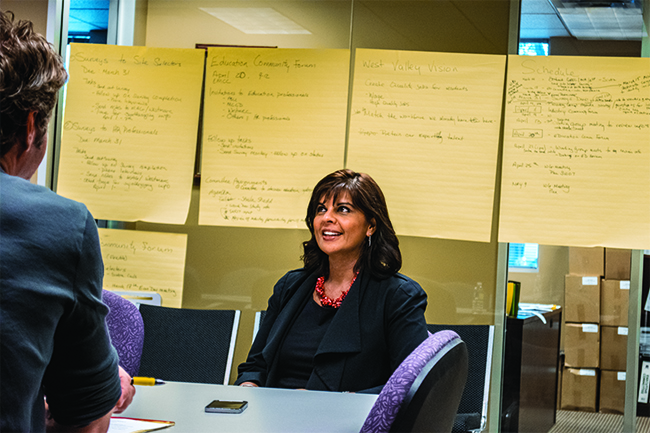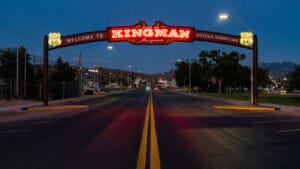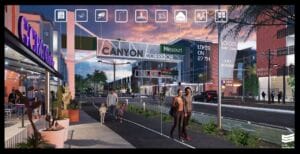When WESTMARC’s board of directors was looking for a new president and CEO to lead the economic development organization, Chairman Bill Sheldon said they were looking for a West Valley brand. In Sintra Hoffman, Sheldon said WESTMARC got a West Valley brand with statewide connections.
Before taking the leadership role at WESTMARC earlier this year, Hoffman served as assistant division director for the Arizona Department of Transportation (ADOT). Hoffman led ADOT’s Office of Public Affairs, which focused on building and sustaining relationships with leaders in Arizona’s cities, towns, counties and business community. Prior to her time at ADOT, Hoffman spent 10 years with the City of Surprise, serving as the director of intergovernmental relations and deputy city manager.
Az Business sat down with Hoffman to talk about all things West Valley.
Az Business: What attracted you to the position at WESTMARC?
Sintra Hoffman: I’ve been a member of WESTMARC for years. When this opportunity came up, they actually called to bounce different names off me and as the conversation went on, (WESTMARC Chairman) Bill Sheldon said, “You really need to apply for this job.” The more we talked about it, the more excited I got because it was an opportunity to really rebuild WESTMARC and recreate it. That’s what really makes me tick: making things my own and working with other people to get things done.
AB: What has been your biggest initial challenge?
SH: The biggest challenge is that industries coming here today want the workforce in place right now. We need to find out what we actually do have and messaging that to them, so we are working on a study to create our Workforce Development Implementation Strategy. The purpose of the study is to identify the workforce we have in the West Valley and show the talent that we have. We know we have the talent to get companies to move here and get them fully staffed, but the perception is that we don’t. This data is going to be huge in getting that message out there.
Then, we need to grow beyond logistics and distribution. It’s kind of a double-edge sword because we have the infrastructure — I-10, soon-to-be I-11, the Loops 303 and 101 — that are very important to logistics, but at the same time, we want to take it to the next level and make sure we are focused on advanced manufacturing, advanced technology and healthcare.
AB: What are WESTMARC’s strengths?
SH: It’s the strength of the membership. The Economic Development Committee is so engaged. They are really vested in this. WESTMARC is more relevant than ever because the competition extends beyond the region. It’s not East Valley vs. West Valley. It’s Phoenix vs. Denver. It’s Phoenix vs. Sacramento. We are really banding together more as a region and I see that as one of WESTMARC’s strengths: the ability to get communities to work together to sell the region and work together effectively and celebrate each other. The crash of the economy taught us all that we are not stand-alone. We need each other.
AB: What are WESTMARC’s priorities or goals for the next year?
SH: No. 1 is getting that Workforce Development Implementation Strategy moving forward and getting the buy-in from all of the West Valley cities. The other piece is marketing that. Peoria does a great job selling Peoria. Goodyear does an amazing job selling Goodyear. What I get to do is market the West Valley as a region and sell the region’s assets on a more global scale.
AB: What kind of impact will the Loop 303 have on economic development in the West Valley?
SH: In my time at ADOT, we always described transportation as the lifeblood and spine of economic development. Some of the things we need to be cautious about is how we plan and develop that corridor because we have multiple jurisdictions that are aligned with Loop 303. We need to make sure we plan diligently and take advantage of the opportunities that will follow.
AB: How has the image of the West Valley changed?
SH: We really don’t have the negative image we had years ago. What we have is an image and perception that we are so far out there. When I worked at ADOT, my co-workers would ask, “Do you live in California?” People know now that the West Valley has great housing — Verrado and Vistancia are gems — but the perception is that there is still a lot of drive time. The reality is that the majority of the West Valley is within 20 minutes of downtown Phoenix.
AB: What sectors do you see as having the greatest potential for economic growth in the West Valley?
SH: I absolutely see the greatest growth coming in healthcare. We have a very strong base in healthcare. Grand Canyon University has a great nursing program and Midwestern University has amazing healthcare programs that are producing the workforce needed to fuel the growth that we are already seeing in the West Valley’s healthcare corridor.
AB: How has the West Valley capitalized on hosting the Super Bowl, the College Football Playoff National Championship and other mega events?
SH: It’s another opportunity to put us on the map nationally and get national exposure. When I first interviewed, I described our two major industries as healthcare and sports. We have the majority of the spring training complexes here, we have the Coyotes, we have the Cardinals and this is a sports town. And we need to market it that way.
AB: What are your goals for WESTMARC?
SH: No. 1 is bringing stability to the organization and getting the word out to the world and using the assets we have to position the West Valley for economic development. What that means to me is that our messaging has to be coordinated. We have a lot of new housing out here and we have a lot of new development, but there is still a lot of dirt out there, so we still have a lot of untapped potential.




